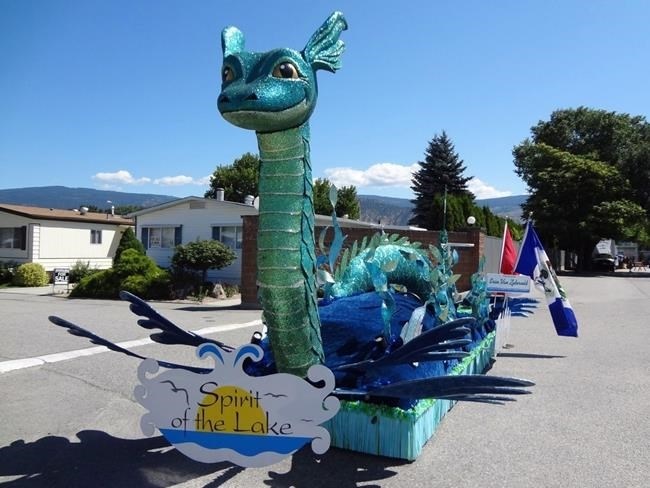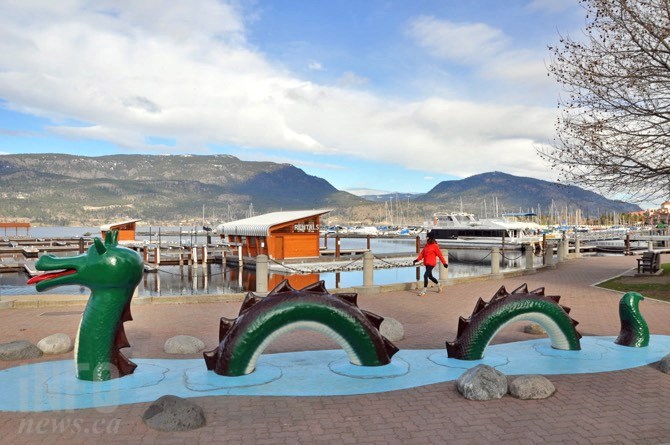
The mythical sea monster Ogopogo is shown on a city of Kelowna float in a handout photo.
Image Credit: Contributed/City of Kelowna
February 29, 2020 - 12:00 PM
The Ogopogo myth is so ingrained in Okanagan culture that people fail to see anything other than lake monsters when waves roll by, a UBC Okanagan professor says.
Robert Young is an earth and environmental science professor at UBC Okanagan and says there are roughly 1,000 lakes around the world that have reported sightings of lake monsters, 34 of which are in B.C. These include weird sightings in Kamloops Lake and legends of the Shuswaggi in the Shuswap.
Stories of the Ogopogo date back thousands of years to when the Interior Salish First Nation people spoke of N’ha-a-itk, the spirit of the lake, according to Tourism Kelowna. Over the years these stories changed as European settlers transformed the stories they heard into a creature, which later became the Ogopogo.
“It’s not unique and of course, there’s the Loch Ness Monster which has been reported for some time,” Young said, adding that when people see something unusual they try to interpret it using their background knowledge. The weight of tales and lore grows with time, so it’s difficult for people to go against their assumptions.
With the Okanagan’s culture so tied with the Ogopogo legend, people assume it’s a lake monster, he said.

(JOHN MCDONALD / iNFOnews.ca)
Just because some scientists may not have an explanation for the unusual waves, doesn’t mean the Ogopogo myth is correct, he said.
“It’s sort of a false logical argument. If I have an explanation and you don’t, then I’m right,” he said.
“Myths and legends are often stories and very often they’re delivered as stories to teach lessons,” he said.
“They’re used as vehicles to transmit other sorts of knowledge and they’re useful from that point of view.”
READ MORE: Ogopogo lives: What two local museums can teach us about reconciliation
“The problem begins when people take the myth as being literally true and then it becomes irrational.”
“This is true of all mythological belief systems, and that’s also a large issue as a working scientist opposing mythological truths,” he said.
There are a few instances in nature that would create rolling waves on a calm day, he said.
In calm seasons, water is densest at 4 C and when the lake surface warms, it becomes denser than the underlying layer so surface water will sink underneath the underlying layer, creating a wave, he said.
Another explanation could be when inter-directional winds blow, it causes one part of the lake to elevate over another, he said. “When the winds stop, then the water settles and you have a considerable current going on and that can cause waves as well.”
The W.R. Bennett Bridge is quite good at helping create these types of Ogopogo-like waves, he said.
READ MORE: Ogopogo isn't the only thing making waves on Okanagan Lake
“People don’t like seeing things that don’t have an explanation. The idea that this is some stranded reptile from the Mesozoic era is nonsense because the valley itself didn’t form until well after the dinosaurs went extinct.”
“This thing would have to be very lonely. How would it reproduce? How would it get around all these lakes?” Young asked.
View these myths as a skeptic, he said, and view them as lessons of knowledge, and not the literal truth.
“That’s my takeaway," he said. "Traditional knowledge shouldn’t be abandoned.”
Stories, he said, are useful to impart wisdom.
To contact a reporter for this story, email Carli Berry or call 250-864-7494 or email the editor. You can also submit photos, videos or news tips to the newsroom and be entered to win a monthly prize draw.
We welcome your comments and opinions on our stories but play nice. We won't censor or delete comments unless they contain off-topic statements or links, unnecessary vulgarity, false facts, spam or obviously fake profiles. If you have any concerns about what you see in comments, email the editor in the link above.
News from © iNFOnews, 2020